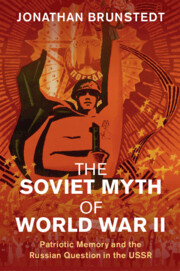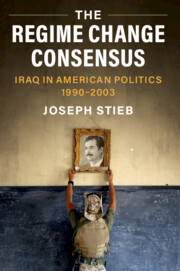Refine search
Actions for selected content:
15401 results in Military history
PART IV - The Age of Mechanized Warfare
-
- Book:
- The Cambridge Illustrated History of Warfare
- Published online:
- 15 July 2021
- Print publication:
- 15 July 2021, pp 228-229
-
- Chapter
- Export citation
Index
-
- Book:
- The Regime Change Consensus
- Published online:
- 18 June 2021
- Print publication:
- 08 July 2021, pp 265-270
-
- Chapter
- Export citation
1 - A Hope, Not a Policy
-
- Book:
- The Regime Change Consensus
- Published online:
- 18 June 2021
- Print publication:
- 08 July 2021, pp 14-53
-
- Chapter
- Export citation
Contents
-
- Book:
- The Regime Change Consensus
- Published online:
- 18 June 2021
- Print publication:
- 08 July 2021, pp vii-vii
-
- Chapter
- Export citation
Acknowledgments
-
- Book:
- The Regime Change Consensus
- Published online:
- 18 June 2021
- Print publication:
- 08 July 2021, pp viii-x
-
- Chapter
- Export citation
Abbreviations
-
- Book:
- The Regime Change Consensus
- Published online:
- 18 June 2021
- Print publication:
- 08 July 2021, pp xi-xii
-
- Chapter
- Export citation
4 - Saddam Must Go: Entrenching the Regime Change Consensus, 1997–2000
-
- Book:
- The Regime Change Consensus
- Published online:
- 18 June 2021
- Print publication:
- 08 July 2021, pp 140-188
-
- Chapter
- Export citation
Introduction
-
- Book:
- The Regime Change Consensus
- Published online:
- 18 June 2021
- Print publication:
- 08 July 2021, pp 1-13
-
- Chapter
- Export citation
Bibliography
-
- Book:
- The Regime Change Consensus
- Published online:
- 18 June 2021
- Print publication:
- 08 July 2021, pp 260-264
-
- Chapter
- Export citation
Conclusion
-
- Book:
- The Regime Change Consensus
- Published online:
- 18 June 2021
- Print publication:
- 08 July 2021, pp 248-259
-
- Chapter
- Export citation
Dedication
-
- Book:
- The Regime Change Consensus
- Published online:
- 18 June 2021
- Print publication:
- 08 July 2021, pp v-vi
-
- Chapter
- Export citation
Copyright page
-
- Book:
- The Regime Change Consensus
- Published online:
- 18 June 2021
- Print publication:
- 08 July 2021, pp iv-iv
-
- Chapter
- Export citation
3 - The Long Watch: The High Years of Containment, 1993–1996
-
- Book:
- The Regime Change Consensus
- Published online:
- 18 June 2021
- Print publication:
- 08 July 2021, pp 98-139
-
- Chapter
- Export citation
5 - Not Whether, but How and When: The Iraq Debate from 9/11 to the Invasion
-
- Book:
- The Regime Change Consensus
- Published online:
- 18 June 2021
- Print publication:
- 08 July 2021, pp 189-247
-
- Chapter
- Export citation
2 - The Fallout from Victory: Containment and Its Critics, 1991–1992
-
- Book:
- The Regime Change Consensus
- Published online:
- 18 June 2021
- Print publication:
- 08 July 2021, pp 54-97
-
- Chapter
- Export citation

The Soviet Myth of World War II
- Patriotic Memory and the Russian Question in the USSR
-
- Published online:
- 24 June 2021
- Print publication:
- 15 July 2021

The Regime Change Consensus
- Iraq in American Politics, 1990-2003
-
- Published online:
- 18 June 2021
- Print publication:
- 08 July 2021

Writing the Nigeria-Biafra War
-
- Published by:
- Boydell & Brewer
- Published online:
- 17 June 2021
- Print publication:
- 15 July 2016
Acknowledgements
-
- Book:
- Queen Victoria's Wars
- Published online:
- 01 June 2021
- Print publication:
- 17 June 2021, pp xii-xiv
-
- Chapter
- Export citation
Index
-
- Book:
- Queen Victoria's Wars
- Published online:
- 01 June 2021
- Print publication:
- 17 June 2021, pp 312-322
-
- Chapter
- Export citation
